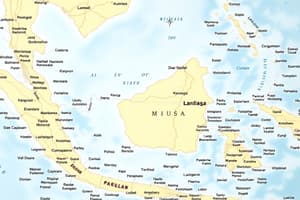Podcast
Questions and Answers
What is the long-term effect of imposed language contact due to invasions?
What is the long-term effect of imposed language contact due to invasions?
- Pidginization
- Code-Switching
- Language Shift (correct)
- Language Maintenance
Which process describes the creation of a new language variety with limited functions?
Which process describes the creation of a new language variety with limited functions?
- Pidginization (correct)
- Dialect Levelling
- Language Shift
- Creolization
In which situation does borrowing typically occur?
In which situation does borrowing typically occur?
- When individuals engage in code-switching
- When languages are used strictly for essential communication
- When speakers need a term for a new concept or object (correct)
- When a dominant language displaces a native language
What denotes the process in which the use of pidgins by later generations leads to a fully developed native language?
What denotes the process in which the use of pidgins by later generations leads to a fully developed native language?
Which of the following is NOT characteristic of borrowing in language contact?
Which of the following is NOT characteristic of borrowing in language contact?
What effect might continuous contact between different dialects lead to?
What effect might continuous contact between different dialects lead to?
What do we call the interruption in the transmission of an indigenous language across generations?
What do we call the interruption in the transmission of an indigenous language across generations?
What is primarily involved in the process of pidginization?
What is primarily involved in the process of pidginization?
What is the long-term effect of language shift on native languages?
What is the long-term effect of language shift on native languages?
Which statement accurately distinguishes between pidginization and creolization?
Which statement accurately distinguishes between pidginization and creolization?
What characteristic defines dialect leveling as described in the context of language contact?
What characteristic defines dialect leveling as described in the context of language contact?
In cases of language death, what are the potential outcomes for the remnants of the language?
In cases of language death, what are the potential outcomes for the remnants of the language?
Which level of language variation represents the intermediate variety in a continuum from a creole to the standard language?
Which level of language variation represents the intermediate variety in a continuum from a creole to the standard language?
What is the primary outcome of direct forced contact with intense pressure regarding language?
What is the primary outcome of direct forced contact with intense pressure regarding language?
Which process is characterized by the mixing of several varieties of a language and the development of new variants?
Which process is characterized by the mixing of several varieties of a language and the development of new variants?
What happens during pidginization in relation to the languages involved?
What happens during pidginization in relation to the languages involved?
What is a key characteristic of a creole language compared to a pidgin?
What is a key characteristic of a creole language compared to a pidgin?
What does direct phonological diffusion imply?
What does direct phonological diffusion imply?
Which process initiates the creation of a pidgin?
Which process initiates the creation of a pidgin?
What is the primary distinction between expanded pidgins and standard pidgins?
What is the primary distinction between expanded pidgins and standard pidgins?
What is the most common linguistic effect observed in language contact situations?
What is the most common linguistic effect observed in language contact situations?
What process describes the gradual reduction of variation within dialects due to contact?
What process describes the gradual reduction of variation within dialects due to contact?
Which characteristic reflects regional and social variation among creole languages?
Which characteristic reflects regional and social variation among creole languages?
What process occurs when speakers modify their speech patterns to align with those of their conversational partners?
What process occurs when speakers modify their speech patterns to align with those of their conversational partners?
What is the result of dialect levelling in a continuous dialect contact situation?
What is the result of dialect levelling in a continuous dialect contact situation?
What is a significant outcome of continued dialect contact after levelling over generations?
What is a significant outcome of continued dialect contact after levelling over generations?
Which statement accurately describes the relationship between dialect levelling and koinéization?
Which statement accurately describes the relationship between dialect levelling and koinéization?
Which linguistic features are more likely to be adopted during the koinéization process?
Which linguistic features are more likely to be adopted during the koinéization process?
What happens to regional forms during the koinéization process?
What happens to regional forms during the koinéization process?
What research context was used to illustrate the concept of koinéization?
What research context was used to illustrate the concept of koinéization?
In what situation does koinéization typically occur?
In what situation does koinéization typically occur?
What characteristic distinguishes pidginization from creolization?
What characteristic distinguishes pidginization from creolization?
What is a key feature of a koiné once it becomes stable?
What is a key feature of a koiné once it becomes stable?
Flashcards
Language Shift
Language Shift
The gradual replacement of one language with another due to the dominance of a foreign language.
Language Death
Language Death
The complete disappearance of a language, often due to sustained language shift or catastrophic events.
Language Revitalization
Language Revitalization
The process of bringing a previously extinct language back to use.
Language Continuum
Language Continuum
Signup and view all the flashcards
Dialects (Basilect, Mesolect, Acrolect)
Dialects (Basilect, Mesolect, Acrolect)
Signup and view all the flashcards
Language Feature Transfer
Language Feature Transfer
Signup and view all the flashcards
Pidginization
Pidginization
Signup and view all the flashcards
Creolization
Creolization
Signup and view all the flashcards
Borrowing (Language)
Borrowing (Language)
Signup and view all the flashcards
Loanwords
Loanwords
Signup and view all the flashcards
Bilingualism/Bidialectalism
Bilingualism/Bidialectalism
Signup and view all the flashcards
Borrowing Necessity
Borrowing Necessity
Signup and view all the flashcards
Pidgin
Pidgin
Signup and view all the flashcards
Creole
Creole
Signup and view all the flashcards
Borrowing
Borrowing
Signup and view all the flashcards
Loanword Adaptation
Loanword Adaptation
Signup and view all the flashcards
Konéization
Konéization
Signup and view all the flashcards
Extended Pidgin
Extended Pidgin
Signup and view all the flashcards
Superstrate
Superstrate
Signup and view all the flashcards
Substrate
Substrate
Signup and view all the flashcards
Accommodation
Accommodation
Signup and view all the flashcards
Dialect levelling
Dialect levelling
Signup and view all the flashcards
Mainstream dialect features
Mainstream dialect features
Signup and view all the flashcards
Regional features
Regional features
Signup and view all the flashcards
Phonological features
Phonological features
Signup and view all the flashcards
Lexical features
Lexical features
Signup and view all the flashcards
Intermediate forms
Intermediate forms
Signup and view all the flashcards
New Town
New Town
Signup and view all the flashcards
Linguistic contact
Linguistic contact
Signup and view all the flashcards
Study Notes
Introduction to Dialectology
- Dialectology studies variations in language use across different geographical regions or social groups.
- Language contact occurs when speakers of different languages or dialects interact.
- This contact can have a variety of effects on the languages involved.
Language/Dialect Contact
- Language contact, either direct or indirect, occurs due to geographical proximity, social interaction, migration, or other factors.
- Speaker interaction, linguistic factors, and socioeconomic factors affect language outcomes.
- Contact can be temporary, intensive, or long-lasting.
Effects of Language/Dialect Contact
- Contact can result in a variety of effects on the interacting languages.
- Linguistic changes, like borrowing, structural convergence (simplification), or dialect leveling (reduction in differences), may occur.
- Social factors, like social status and power dynamics between the involved speakers, also play a critical role.
- The degree of contact (e.g., intensity, duration) affects outcomes.
Borrowing
- Borrowing is the acquisition of linguistic elements (e.g., words, sounds, syntax) from another language or dialect due to interaction.
- Borrowed material is often lexical items, such as loanwords.
- Borrowing can occur due to necessity (e.g., naming a new object or concept) or prestige (e.g., adopting terms from a prestigious language).
- Loanwords are often adapted to fit the phonology of the receiving language.
Koinéization
- Koinéization is the development of a new mixed language variety following dialect contact.
- It is a result of accommodation, where speakers modify their speech to be more intelligible to others.
- The resulting variety often adopts features of the involved languages.
- Often mainstream dialects are selected over regional features
- The number of available forms/variants reduces as the contact continues
Dialect Leveling
- Dialect levelling is a process that results in the simplification or homogenization of distinct dialects due to contact.
- It typically leads to a reduction in the perceived differences between dialects in terms of syntax, lexis and pronunciation.
- Factors like geography, migration, status of varieties and socioeconomic background affect the outcome.
- Dialect levelling is a significant factor preceding Koine formation
Pidginization
- Pidgins arise from initial pre-pidgins or jargons.
- They're used by speakers of mutually unintelligible languages for specific purposes, like trade or interaction .
- They typically have a simple structure, primarily borrowing vocabulary from one of the involved languages.
- Further development can lead to a pidgin becoming a more stable means of communication.
- The structural rules and norms form a new language to be called pidgin
Creolization
- Creoles emerge when pidgins become the first language of a community.
- They developed into languages with more complex grammar, morphology, and vocabulary.
- They often display considerable variety based on regional differences and the social background of the speakers.
- Creoles generally are more complex than pidgins.
- Creoles can range from the acrolect, most standardized dialect form, to the basilect, the deepest regional variety.
Language Shift and Language Death
- Language shift occurs when speakers of a language or dialect adopt another language for reasons including social acceptance or mobility.
- This can lead to language loss and ultimately language death.
- Extinct languages, even from natural disasters, can be revitalized if remnants or records remain.
Recap
- Language contact influences the development of languages, including borrowing, koinéization, dialect leveling, pidginization, and creolization.
- Contact affects all aspects of language. Outcome of contact is language change. The unique combination of factors determines the impact.
- Speakers may adopt elements from another language to facilitate communication.
Studying That Suits You
Use AI to generate personalized quizzes and flashcards to suit your learning preferences.




